|
HINDUISM
Point Pedro Arthiady Pillaiyar Temple :
Spiritual glory of Lord Ganesha
G. Arulanandan
Arthiady Pillaiyar temple which is dedicated to Lord Ganesha is
situated at Puloly West, Point Pedro in Vadamarachchy area. This temple
is the Guardian Deity of the devotees of Arthiady, Thambasiddy and
surrounding areas. Further this temple which is dedicated to God
Pillaiyar is a historical temple and the reconstruction and restoration
took place a few years ago with the co-operation, assistance and support
or the people of the area and several philanthropists and the board of
trustees of this temple.
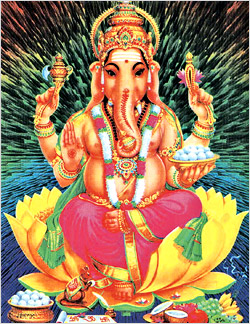 |
|
Pillaiyar
is worshipped in all Hindu temples,
Hindu homes and all Hindu ceremonies to
invoke the blessings of Him. |
Pillaiyar is worshipped in all Hindu temples, Hindu homes and all
Hindu ceremonies to invoke the blessings of Him. Even the celestial
beings are said to have worshipped him before embarking on any important
functions or ceremonies.
God Ganesha holds a hatchet in one hand which symbolises the cutting
away of vanity and false teachings. He also holds on ‘Ankusha” to cut
through illusion and in another hand a noose (PASA) which represents,
the restraining of passions and desires. In his fourth hand, he holds a
sweet (Modakam) with the external tasteless past of rice flour and an
internal tasty parts of taggary and coconut. They symbolise the universe
where the outward worldliness has no worth, but in this is the Bliss'.
Significance
The bulky body of Pillaiyar stands for this cosmos in its entirety.
The huge pot belly signifies space containing all things and beings of
the world. He has a snake which indicates energy is all forms. The idea
contained in the concept is that all things have this allotted place in
the womb of native and they are all supported by the cosmic energy.
His trunk represents the sensitive reception of stimuli and cognition
which signifies the faculty of discrimination. Further, he is single
tusked. The broken tusk signifies that he has broken away from ignorance
which hides the path of God. The single tusk also denotes single
mindedness in action.The other tusk indicates highest knowledge.
His broad ears signify that he hears everything communicated to him.
They indicate omniscience. The three eyes of Lord Ganesha represent the
Moon, the Sun and Fire, which in turn indicate the three phases of
creation, sustenance and destruction. The third eye is a symbol of
intuitive knowledge.
Divinity
Lord Ganesha uses His little mouse as His vehicle. This signifies all
beings high and low, big and small are the vehicles of divinity
enshrined in the hearts. The little mouse also stands for time. God is
beyond time. He is the controller of time and so he rides over the
aspect of time. In fact, the mouse is the appropriate symbol of time.
The mouse alas personifies the evil qualities like anger, pride and
selfishness. Lord Ganesha riding the mouse shows that He keeps the evil
passions always under check. Furthermore, a common form of worship of
Lord Ganesha is rapping at the forehead with and pulling Earlobes with
cross hands. This act helps in the purification or the Naadis.
God Ganesha or Pillaiyar worship is extremely popular in Indonesia,
Sumatra and Java. Further, the Camphor that is burnt during poojas in
front of God Ganesha signifies that we have to burn our illusion or Ego
with the fire of time knowledge and leave no residue, so that we may
merge with God.
Hence, let us pray to Arthiady Pillaiyar temple at Point Pedro and
receive His Divine Blessings, His universal love and compassion so that
we may be bathed by His spiritual glory and splendour to acquire
spiritual attainments, everlasting peace, eternal prosperity and
happiness.
Glories of Thiruketheeswaram
Chelvatamby Maniccavasgar
Thiruketheeswaram is an ancient and historical temple in Manthoddam
situated in the Mannar District about seven miles north of the Mannar
town. According to the legends, this temple is considered to be famous
since “Kethu Bagavan” worshipped “God Shiva” or “Lord Eeswaram”. Hence
the Holy Shrine acquired the name “Thiruketheeswaram”
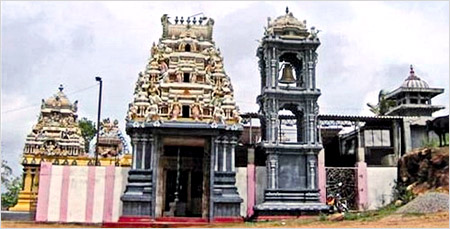 According to the great historian Dr Paul Peiris that long before the
arrival of Vijaya (6th century BC) there was in Ceylon five recognized
Eeswarans of Lord Shiva which claimed and received adoration of Ceylon
and India. These were Thiruketheeswaram, Munneswaram, Thandeswaram,
Thirukoneswaram and Naguleswaram. According to the great historian Dr Paul Peiris that long before the
arrival of Vijaya (6th century BC) there was in Ceylon five recognized
Eeswarans of Lord Shiva which claimed and received adoration of Ceylon
and India. These were Thiruketheeswaram, Munneswaram, Thandeswaram,
Thirukoneswaram and Naguleswaram.
Even another well-known historian “Cassiechetty” had said that
Manthoddam was a centre of International Trade. Thiruketheaswaram which
is dedicated to the worship of the Supreme God Shiva has been the most
venerated temple for centuries. This temple and the holy waters of
Palavi Tank by its side are venerated in the sacred hymns of the two
foremost Saiva saints namely “Thirugnanasampanthar” and “Sundadar” who
lived in the 7th and 8th centuries respectively.
This great temple was completely destroyed by the Portuguese in the
16th centuries and the very stones of this temple were used by them to
build the Fort of Mannar and the Churches.
In fact, Sri La Sri Arumuganavalar who was responsible for
renaissance of Saivism in Sri Lanka in the 19th century made the Hindus
to realize that they were duty bound to rebuild this historic temple.
Following his appeal made in 1872, a small temple was reconstructed in
1903. In 1921, the Central shrine was constructed and the consecrvation
ceremony was held.
Indeed, on 28th October 1948, a “Temple Restoration Society” was
formed, which dedicated itself to the task of building a proper Shivan
Temple in conformity with Saiva Agamas and with sculptured granite
stones. Work was commenced on 28th November 1953 and it was completed on
14th September 1956. The consecration ceremony of the renovated temple
was held on 31st October 1960 and further renovations were done by the
Temple's Restoration society and the Maha Kumbabishekam was held on 4th
July 1976.
Contribution
Eventhough, several devotees and philanthropists had done tremendous
service for the restoration and renovation of this ancient temple, “Sir
Kandiah Vaithyanathan” was the first person, who was a civil servant
performed numerous restoration works for this temple.
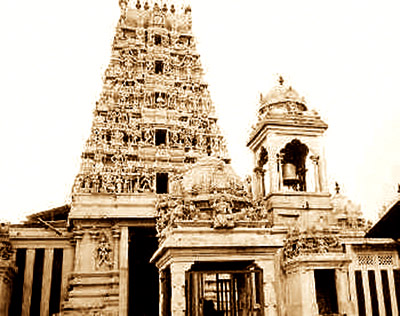 Even the great Tamil and Saiva Scholar S Sivapathasunderampillai, who
was born in Puloly, Point Pedro on 17.01 1878 rendered immense service
to the Thiruketheswarm temple in various ways with the help and
co-operation of eminent sculptor “Chella Kanna”. Even the great Tamil and Saiva Scholar S Sivapathasunderampillai, who
was born in Puloly, Point Pedro on 17.01 1878 rendered immense service
to the Thiruketheswarm temple in various ways with the help and
co-operation of eminent sculptor “Chella Kanna”.
Further, E Namasivayam who was the secretary and President of this
temple restoration society for several years took all possible and
positive steps for the betterment and improvement of this temple.
Saiva Periyas R Namasivayam, an Attorney-at-law and a Saiva scholar
was born on April 11, 1912 in Atchuvely in an illustrious family, whose
parents Rasapillai and Sithampara Nachchiyas were greatly involved in
the development and promotion of Hindu Religions and Hindu Culture. He
received his early education at Moolai Saivapragasa Vidyalayam,
Siththankerney Hindu College and thereafter Jaffna Hindu College.
In fact, he received his higher education at Chulipuram Victoria
College and entered the Law College in 1935 and passed out as a Proctor
in 1941.
Eventhough, he practised as a Lawyer he was very much interested in
Saiva Siddantam, Saiva Neri and Saiva Agamas.
Indeed Saiva Periyar Namasivayam's greatest contribution to Saivism
was his service to the ancient Thiruketheeswaram's temple's restoration
works.
Rare dynamism
Blessed with a seemingly in exhaustible supply of energy, enthusiasm,
inspiration and quickness of thoughts, he accomplished several
construction, restoration and renovation works at Thiruketheeswaram
temple. Further, no field of endeavours was left untouched by the
swaying amplitude of his imagination, the encompassing sweep of his
thought, the penetrating, yet lucid felicitation of his words and the
indefatigable zeal of his actions. Most of the works he performed were
to give a new look to this ancient and historical temple
Thiruketheeswaram and all were done by him with rare dynamism and
exemplary zeal. He did everything with extra sense of devotion, ,
dedication, determination and commitment to provide better facilities to
the numerous devotees who frequently visit this temple to receive the
divine blessings of Lord Shiva.
“Saiva Periyar” Namasivayam has written several articles pertaining
to Thiruketheeswaram temple and its ancient glory.
In fact, “Saiva Periyar” Namasivayam was also the Vice President of
Colombo Tamil Sangam from 1970-1975 and rendered yeoman service for the
betterment of the Tamil Sangam. In appreciation and recognition of his
religious works particularly in relations to the restoration and
renovation work he did at Thiruketheeswaram temple, the
“Thiruvavaduthurai Aatheenam conferred him with the title “Shivappani
Chelvar”.
Furthermore, the Express Newspapers of (Ceylon) Ltd has made
elaborate arrangements to release a Book on “Life and Times of
“Saivapperiyar” R Namasivayam and his contribution to the restoration of
Thiruketheeswaram written by the great historian and religious scholar
and former Professor of History in the University of Peradeniya Prof S
Pathmanathan. In fact, Kumar Nadesan, Managing Director of ENCL and Dr
Rajan Namasivayam have taken all possible steps to release this book on
25.04.2013 at Bambalapitiya Saraswathy hall at 5.30 pm. The Art work and
designing were done by the ENCL-ICT Department Manager M S T Thayalan in
a shortest possible time and he deserves our congratulations.
Significance of Nanthi Flag and Thevaram recital
G Arulanandan
In the history of the world every five nation has stood for a
particular idea which it has sought to weave into the fabric of the
lives of the people. The Germans made the concept of beauty essentially
their own, the rule of law moulded the pattern of the Britishers.
Likewise long before the Greeks and Britishers, the Hindus were told to
govern their lives by the norms of Dharma which comprehends for an ideal
humanity.
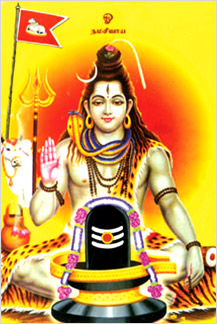 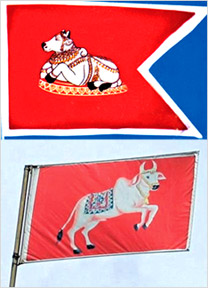 Further, Dharma is an internal discipline by which a given social
order is protected. It is by Dharma that civilization is maintained.
Therefore, Dharma may be defined as social norms or moral law. Since
Nanthi or the Sacred Bull is said to be the vehicle of Lord Shiva, it
also means that Dharma is the vehicle of Lord Shiva. Further, Dharma is an internal discipline by which a given social
order is protected. It is by Dharma that civilization is maintained.
Therefore, Dharma may be defined as social norms or moral law. Since
Nanthi or the Sacred Bull is said to be the vehicle of Lord Shiva, it
also means that Dharma is the vehicle of Lord Shiva.
To an ordinary Hindu, Nanthi represents the physical of Lord Shiva in
the form of a Bull. Lord Nanthi is a manifested energy or dynamic motion
that is felt in the invisible and partly visible nature of the micro or
micro cosmos and in the visible objective nature it is a vehicle.
Indeed, there is a flag for every nation, every religion and every
political party without any exception. They hoist their flags during all
important occasions and celebrations and the whole world comes to know
their respective celebrations on account of their flag hoisting
ceremony. But, there is no such flag common to Hindus hoisted during
festivals or ceremonies anywhere in the world.
Significance
Further, Nanthi stands for sacrifice, devotion, detachment,
perception, tolerance, humility, service and what is more, it is hailed
as God himself. Therefore, the Nanthi flag singifies all such lofty
values of Saivities. That really is the significance of the Nanthi flag.
Whenever and wherever Lord Shiva appeared before his ardent devotees
to bestow a boon, he gave Dharshan as appearing on his vehicle, Nanthi.
When Saint Tirugnanasambanthar had Lord Shiva Dharshan for the first
time in his infancy, what he saw was Lord Shiva with his consort on his
vehicle Nanthi. It has been so with all saints and devotees.
Furthermore, in Hinduism every God has an associated vehicle. For
example, Lord Ganesha has the rat, Goddess Saraswathy has the Swam and
Lord Muruga has the peacock. In fact, the flag hoisting ceremony in
temples indicates that the discended Kundalani Sakthy at Moolatharam of
our spinal chord should rice to the head.
Flag lowering ceremony
The flag lowering ceremony indicates that the Supreme Consciousness
descends down from the head to the body (creation) and reach the end of
the spinal chord (Moolathanam). Besides, the hoisting of the Nanthi Flag
at the top of the Rajagopuram of the temple or in any other religious
functions will undoubtedly explain the principles and philosophy of
saivism to achieve the goal of life.
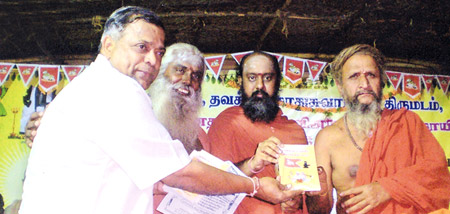 |
|
“Vidaikodi Chelvar” Dr. Sinnadurai
Dhanabalaa is seen presenting the book titled “Nanthi Kodi
Atreet! Kodik Kavi Paadeer!” to the heads of Aatheenams in
India namely “Thavaththiru Sadu Shanmuga Adikalar,
“Thulavoor” “Thavaththiru” Gnanapirakasa Swamigal and
“Thavaththiru Maruthasala Adikalar. |
Realizing the significance and importance of Nanthi Flag, the
“Vidaikodi Chelvar”, Dr Sinnadurai Dhanabalaa compiled a book and
published on “Significance and the glories of Nanthi Flag” a few years
ago, which was distributed not only in Sri Lanka, but throughout the
world among Hindus and saivitis with the Blessings of the heads of all
Aatheenans in India.
Recently, he published a book titled “Nanthi Kodi Atreet! Kodik Kavi
Paadeer”. In this book, most of the articles on Nanthi Flag were written
by eminent personalities and great scholars and educationists. In fact,
they have highlighted the importance of hoisting Nanthi Flag and how it
should be hoisted during the Temple festivals and religious ceremonies.
In fact, during the Thiruvembavai festival which is usually held in the
month of December in Shivan Temple in “Chithambaram” in India.
This festival always commences with the Flag hoisting ceremony by
“Thillai Vaal Anthanar” But, on the occasion of the flag hoisting
ceremony the “Thillai Vaal Anthanar” took tremendous effort to hoist the
Flag. They could not succeed in hoisting the Flag. Indeed, they were
thoroughly disappointed and disillusioned. But, to their surprise there
was a voice from the air, asking them to approach “Umapathysivam” who
was living in a village called “Kottravan” in India. When, “Thillaivaal
Anthanar” explained to “Umapathyshivam” all what really happened, he
went to the temple and started reciting “Thevarams” with utter devotion
and the Flag was hoisted without any difficulties and all were extremely
happy.
Recently, “Vidaikodi Chelvar” Dr Sinnadurai Dhanabala went to India
and participated at Thavaththiru Sathu Swamigal Thirumada 100th
Anniversary celebrations and Thavath Thiru Sathu Sanmuga Adikalar's
Diamond Jubilee celebrations and distributed Nanthi Flags with the
Blesings of the heads of Aatheenams in India.
Hence, in all temple festivals and religious functions, let us hoist
Nanthi Flags with reciting Thevarams and receive the blessings of God
Shiva. |





